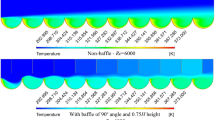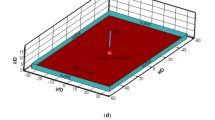Abstract
Pipes are widely used to transport gas, oil and water in industries. Drag reduction in pipes is an increasingly concerned problem to save energy. Some researches have indicated that the non-smooth surface with special structures can reduce flow loss. In this paper, an experimental investigation has been performed on the effects of a kind of surface groove on the drag in both rectangular and circular duct at different Reynolds numbers. In the experiment of the rectangular duct, total pressure at both inlet and outlet were measured. Static pressure on the wall was measured on the surface with smooth and grooved film respectively. In the circular duct, a boundary layer pressure probe was used to measure the total pressure distribution at both inlet and outlet. Four taps at inlet and outlet were used to measure static pressure. The loss coefficient is used to evaluate the effects of the surface groove on drag reduction. The experiment was conducted with the Reynolds number range from 1.28×104 to 2.57×104. The result shows a maximum drag loss reduction of approximately 2.4% in rectangular duct at Reynolds number of 2.4×104. A 10% reduction of pipe pressure loss by grooved surface is measured in circular duct at a Reynolds number of 3.0×105.
Similar content being viewed by others
References
Walsh, M.J.: Drag and heat transfer on surfaces with small longitudinal fins. AIAA Pap. No. 78-1161, (1978)
Walsh, M.J.: Drag characterization of V-groove and traverse curvature riblets. In: Viscous Drag Reduction (ed. Hough, G.H.), Vol.72, Progress in Astronautics and aeronautics, pp. 168–184, (1979)
Walsh, M.J.: Turbulent boundary layer drag reduction using riblets. AIAA Pap. No. 82-0169, (1982)
Walsh, M.J.: Riblets as a drag reduction technique. AIAA J.21. No. 4, 485–486, (1983)
Walsh, M.J.: Riblets. In: Prog. Astronaut. Aeronaut. 123, 203–261, (1990)
GONG Wu-Qi: Experiment study on the Mechanism of Riblets Drag Reduction, Journal of Engineering Thermophysics, Vol.23, No.5, (Sep., 2002) (in Chinese)
Bushnell, D.M.: Turbulent drag reduction for external flows. Aircraft drag prediction and reduction. AGARD R-723, 5-1 to 5-26, (1985)
J.J. Rohr: A comparison of the drag-reducing benefits of riblets in internal and external flows, Experiments in Fluids 13, 361–368, (1992)
A.R. Moore and M.V. Lowson: Drag Reduction in a Rectangular Duct Using Riblets, Aeronautical Journal, (May., 1995)
MA Hongwei, TIAN Qiao and WU Hui. Experimental Study of Turbulent Boundary Layers on Groove/Smooth Flat Surfaces. Journal of Thermal Science, 2005(3): 193–197
Author information
Authors and Affiliations
Additional information
This work was funded by the National Natural Science Foundation of China, Grant No. 51161130525 and 51136003, supported by the 111 Project, No. B07009.
Rights and permissions
About this article
Cite this article
Ma, R., Ma, H., Zhang, Z. et al. Effects of a kind of surface groove on flow loss in both rectangular and circular ducts at different Reynolds numbers. J. Therm. Sci. 25, 389–393 (2016). https://doi.org/10.1007/s11630-016-0875-6
Received:
Published:
Issue Date:
DOI: https://doi.org/10.1007/s11630-016-0875-6




